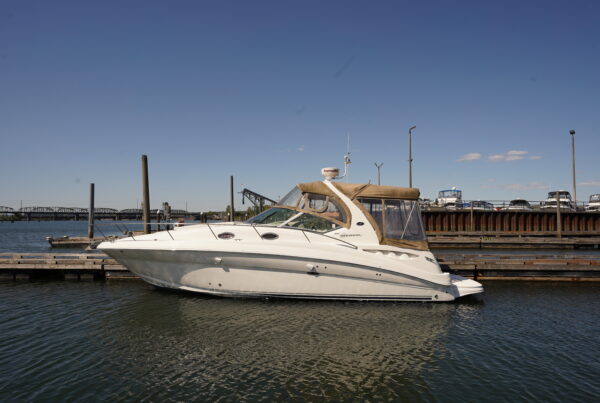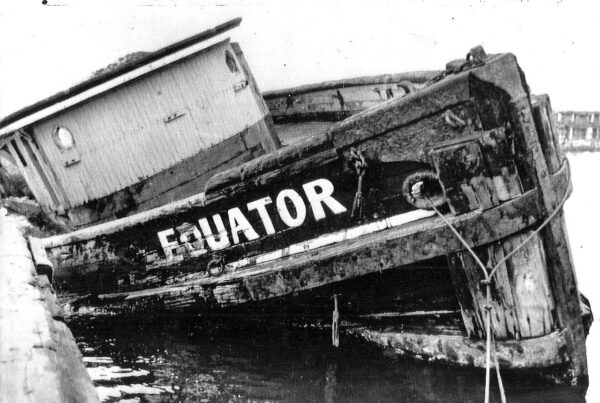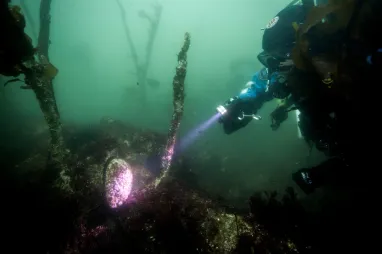Scuba diving and boating are two exhilarating activities that offer a unique and exciting experience for water enthusiasts. The fusion of these two activities can open up a world of underwater wonders. In this article, we will cover topics such as; how to get started with scuba diving, finding good diving areas from your boat, and the equipment you can store on board.

How to get started Scuba Diving:
Scuba diving allows you to discover the hidden treasures of the underwater world. The serene beauty of coral reefs, vibrant marine life, and the weightless sensation of being submerged in water create an unparalleled experience. To get started with scuba diving, you’ll need to undertake a few essential steps.
First, it’s crucial to receive proper training from a certified scuba diving instructor or school. They will guide you through the necessary knowledge, skills, and safety protocols to become a competent and confident diver. You can find reputable diving centers near you by conducting a quick online search or asking for recommendations from experienced divers.
The next step involves obtaining scuba diving certification. Popular certification agencies include PADI (Professional Association of Diving Instructors) and NAUI (National Association of Underwater Instructors). These organizations offer comprehensive courses that include classroom sessions, pool training, and open water dives. Through these courses, you’ll learn about dive theory, equipment usage, underwater navigation, and safety procedures.
Once you’ve completed your training and earned your certification, the world of scuba diving is yours to explore. From diving in exotic locations to participating in underwater conservation efforts, the possibilities are endless. Scuba diving can be a source of thrilling adventures, incredible discoveries, and memorable encounters with marine life. It’s a sport that allows you to continuously learn as you explore new depths and expand your diving skills.
How to find good areas for Scuba Diving from your boat
When it comes to combining scuba diving with boating, finding suitable areas to dive is essential. One way to discover excellent diving spots is through diving reports available online. These reports provide valuable information on dive sites. This includes underwater topography, marine life, and visibility conditions. Here are a few tips on finding diving reports:
a) Online Diving Communities: Joining online diving communities or forums can connect you with experienced divers who are willing to share their knowledge. Platforms like ScubaBoard and DiveBuddy allow users to ask questions, share dive reports, and provide recommendations based on personal experiences.
b) Dive Operator Websites: Many dive operators have websites that showcase the dive sites they visit. These websites often include detailed information about each location, such as dive site descriptions, depth ranges, and difficulty levels. By browsing through these websites, you can gather valuable insights and select suitable dive spots based on your preferences and skill level.
c) Social Media: Social media platforms like Instagram and Facebook have a thriving scuba diving community. Following diving-related accounts and hashtags can expose you to breathtaking underwater photography and insights from divers worldwide. Additionally, some divers and dive operators share dive reports on their social media profiles.
Remember to cross-reference information from multiple sources to ensure accuracy and up-to-date conditions. It’s also advisable to consult local dive shops or dive operators who have firsthand knowledge of the area you plan to explore. Their expertise can provide valuable insights and enhance your diving experience.

What equipment you can store on your boat:
Combining boating and scuba diving offers the advantage of having a floating base from which to explore diverse dive sites. When it comes to storing scuba diving equipment on your boat, here are a few items to consider:
a) Dive Tanks and Compressor: Dive tanks are an essential part of scuba diving, and having a compressor on your boat allows you to refill them between dives. Ensure that you have adequate space to store tanks securely, taking into account safety considerations and weight distribution.
b) Dive Gear: Scuba diving gear includes a wetsuit or drysuit, buoyancy control device (BCD), regulator, mask, fins, and weight belt. Having dedicated storage compartments or racks on your boat can keep your gear organized and easily accessible.
c) First Aid Kit and Safety Equipment: Safety should always be a top priority when engaging in scuba diving. Carry a well-equipped first aid kit onboard, including supplies specifically for dive-related injuries. Additionally, having safety equipment such as emergency oxygen and a dive flag can enhance your preparedness during dives.
Boating and scuba diving go hand in hand, as both activities allow you to explore the vast expanse of the ocean. Boats provide a means of transportation, allowing divers to access remote or less crowded dive sites that may not be reachable from the shore. Moreover, boating offers the convenience of having all your dive equipment readily available on board, eliminating the need to transport gear separately.
As you anchor your boat near a dive site, you can enjoy the scenic beauty of the surrounding area while preparing for your underwater adventure. After a satisfying dive, you can use the boat’s facilities to rinse off saltwater and store your gear safely. Boating and scuba diving complement each other, offering a seamless integration of two captivating water activities.
In conclusion, combining scuba diving and boating creates a synergistic experience that brings together the freedom of exploration above and below the water’s surface. By following the steps to get started with scuba diving, exploring diving reports online, and ensuring proper storage of equipment on your boat, you can embark on a thrilling journey that combines the best of both worlds. So, set sail, dive into the depths, and immerse yourself in the wonders of the underwater world while enjoying the freedom of boating.
Visit our article library for content on all things boating!




